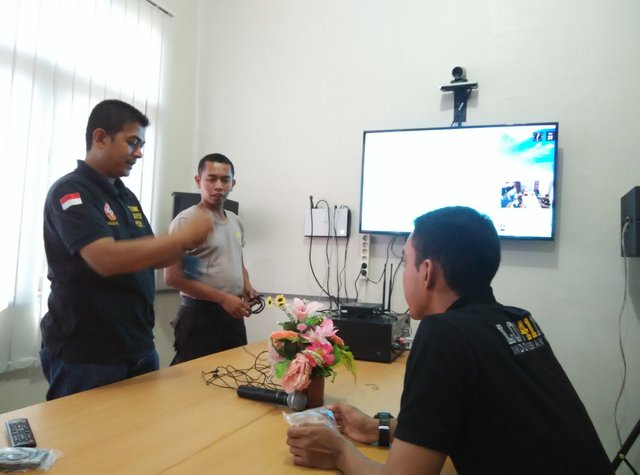Vidio Converence

The core technology used in video conferencing is a compressed digital audio and video stream system. The hardware or software that performs compression is called the codec. Compression figures can be achieved up to 1: 500. The resulting digital flow of 1s and 0s is divided into packet labels, which are then transmitted over a digital network (usually ISDN or IP). The use of an audio modem in a shipping channel allows the use of Plain Old Telephone System or POTS, in some low speed applications, such as videotelephony, because POTS converts the digital vibrations to or from analog waves within the audio spectrum range.
Other components needed for video conferencing systems include:
Video input: video camera or webcam
Video output: computer monitor, television or projector
Audio input: microphone
Audio output: usually a loudspeaker associated with a display device or phone
Data transfer: analog or digital telephone network, LAN or Internet
There are basically two types of video conferencing systems:
Dedicated systems have all the required components packed into one piece of equipment, usually a console with a high quality remote control video camera. This camera can be controlled remotely to rotate left and right, up and down and zoom in, later known as PTZ cameras. The console contains all electrical connections, computer controls, and software or hardware based codecs. The omnidirectional microphone is connected to the console such as a television monitor with a loudspeaker and / or video projector. There are several types of devices dedicated to video conferencing:
Large group video conferences: non-portable, large, more expensive devices used for large rooms and auditoriums.
Small group video conferencing: non-portable or portable, smaller, cheaper devices used for small conference rooms.
Individual video conferencing: usually a portable device, meant for one user, has a fixed camera, microphone, and loudspeaker integrated into the console.
Desktop systems usually add hardware boards to a normal personal computer and transform them into video conferencing devices. Different cameras and microphones can be used with boards, which contain the necessary codecs and face-to-face delivery. Most desktop systems work with standard H.323. Videoconferencing is done through a scattered computer, also known as an e-meeting.
Acoustic echo cancellation Edit
The fundamental feature of a professional video conferencing system is Acoustic Echo Cancellation or AEC. Echo can be defined as a source of interference waves that are reflected by new waves created by the source. AEC is an algorithm capable of detecting when sound or speech reentry into audio input from video conferencing codec, which comes from audio output from the same system after some time. If not checked, may cause some problems such as:
Hearing your own voice (usually delayed significantly).
Powerful echoes, making the voice channel useless because it's hard to understand.
Howling is generated by feedback.
Echo cancellation is an intensive processor task that usually works over a narrow range of voice delays.
Multipoint videoconference Edit
Shared video conferences between three or more distant places are possible through the Multipoint Control Unit or MCU. MCU is a bridge connecting calls from multiple sources in a manner similar to conference audio calls. All parties call MCU units, or MCU units may also contact the parties to participate, respectively.
There is a MCU bridge for IP and ISDN-based video conferencing. There is a pure MCU software, and the other is a combination of hardware and software. An MCU is characterized based on the number of simultaneous calls that can be handled, the ability of the MCU to make protocol changes and data rates as well as other features. MCU can stand alone as hardware or can be incorporated into a dedicated video conferencing unit.
Some systems are capable of multipoint conferences without MCU. It uses the standard H.323 technique known as decentralized multipoint, in which each station in multipoint calls exchanges video and audio directly with another station without setting center. The advantage of a technique without MCU is that video and audio are generally of a higher quality because they do not have to be delivered via a central point. In addition, users can make ad-hoc multipoin calls regardless of availability or control of the MCU.
Congratulations! This post has been upvoted from the communal account, @minnowsupport, by jayakupi from the Minnow Support Project. It's a witness project run by aggroed, ausbitbank, teamsteem, theprophet0, someguy123, neoxian, followbtcnews, and netuoso. The goal is to help Steemit grow by supporting Minnows. Please find us at the Peace, Abundance, and Liberty Network (PALnet) Discord Channel. It's a completely public and open space to all members of the Steemit community who voluntarily choose to be there.
If you would like to delegate to the Minnow Support Project you can do so by clicking on the following links: 50SP, 100SP, 250SP, 500SP, 1000SP, 5000SP.
Be sure to leave at least 50SP undelegated on your account.